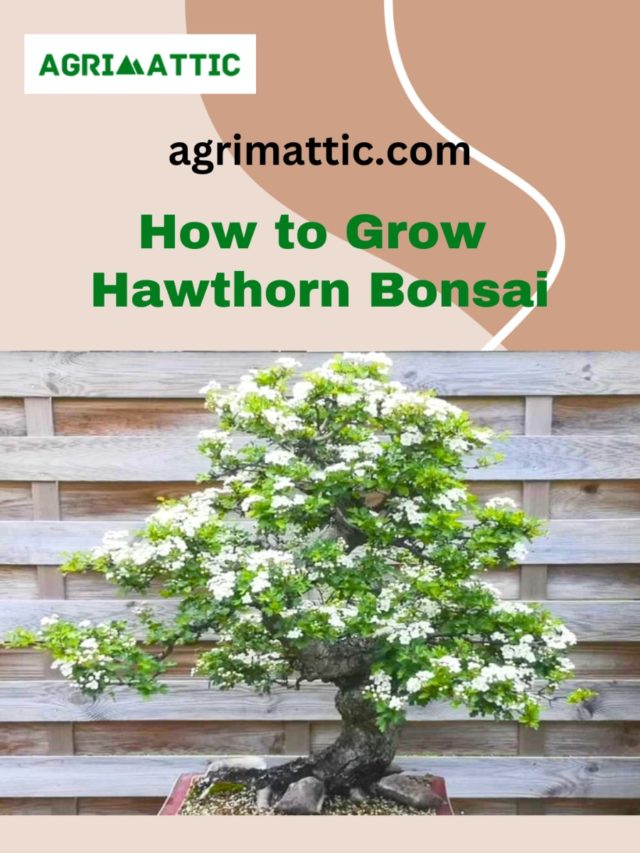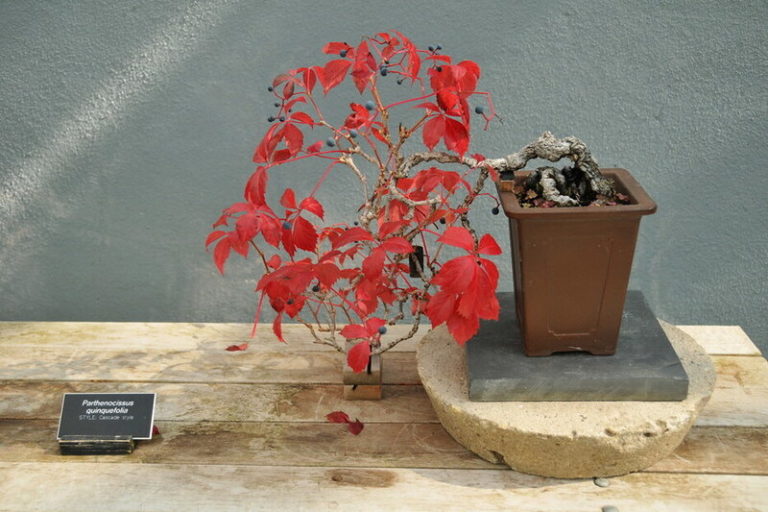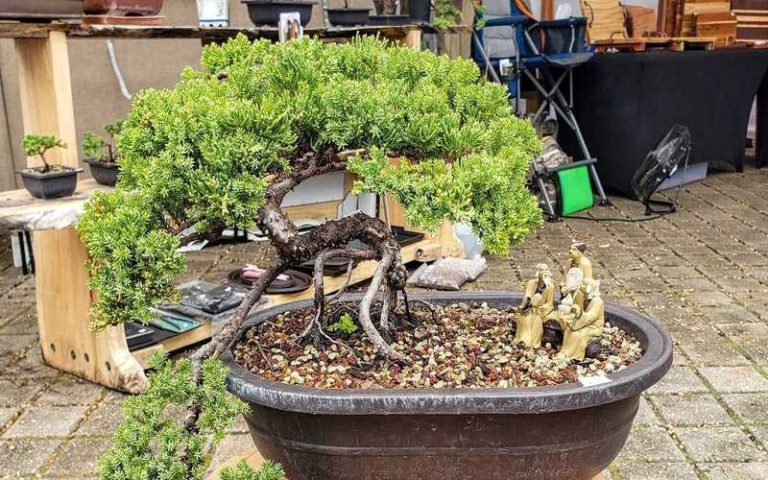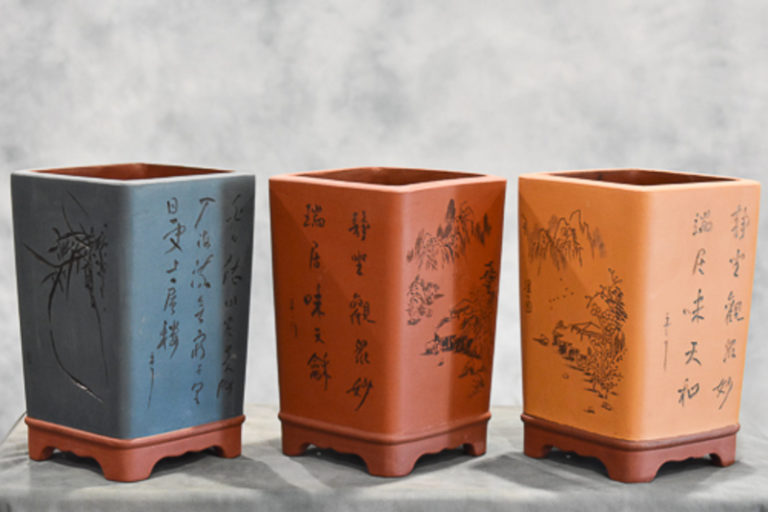Hawthorn Bonsai : A Beautiful Addition to Your Bonsai Collection
Consider adding hawthorn bonsai to your collection if you’re searching for a new addition. Due to its tenacity and distinctive qualities, this lovely tree has gained increasing popularity in bonsai cultivation.
What is Hawthorn Bonsai?
A hawthorn bonsai is a diminutive hawthorn tree that has been trained and cultivated to thrive in a small container. Bonsai cultivation is an ancient art form that originated in China over a millennium ago, and hawthorn bonsai likely originated there as well.
Hawthorn bonsai is created by carefully shaping and training a young hawthorn tree to grow in a particular way using pruning, wiring, and other techniques. Hawthorn bonsai is valued for its hardiness and unique characteristics, including thorny branches, beautiful flowers, and fruit. With proper care and maintenance, hawthorn bonsai can thrive and bring beauty to any space.
History and Origins of the Hawthorn Bonsai
The history and origins of hawthorn bonsai can be traced back to China, where the art of bonsai cultivation began more than a millennium ago. The Chinese were the first to cultivate miniaturized trees and to devise the techniques still used today for shaping and training them.
Hawthorn bonsai probably developed in China, where the hawthorn tree is indigenous. Hawthorn has been grown in China for ages due to its usefulness as both a medicine and a decorative plant. The hawthorn tree has been depicted in Chinese art and literature several times because of its significant cultural heritage.
The skill of bonsai horticulture migrated to Japan in the nineteenth century, where it was polished and developed further. Bonsai experts in Japan began to experiment with many tree species, including hawthorn, and devised new ways for shaping and training the trees.
Hawthorn bonsai is becoming a popular choice for bonsai aficionados all over the world. The resilience and distinctive properties of the hawthorn tree make it an ideal species for bonsai maintenance. Hawthorn bonsai can grow and provide beauty and delight to any place with appropriate care and upkeep.
Types of Hawthorn Bonsai
There are several hawthorn species and cultivars suitable for bonsai growth. The following are some of the most frequent forms of hawthorn bonsai:
Crataegus laevigata: Also known as English hawthorn, this species is native to Europe and produces beautiful pink or white flowers in the spring.
Crataegus pinnatifida: This plant, sometimes known as Chinese hawthorn, is endemic to China and bears little red or yellow fruits that are commonly used in traditional Chinese medicine.
Crataegus cuneata: This unique Japanese shrub, sometimes known as Japanese hawthorn, blooms in the spring with white or pink blossoms.
Crataegus monogyna: Also known as common hawthorn, this species is native to Europe and produces white or pink flowers in the spring.
Crataegus douglasii: This species, often known as black hawthorn, is endemic to North America and bears little black fruits.
There are various more hawthorn species and cultivars ideal for bonsai growth, each with their unique set of characteristics and needs. To keep your hawthorn bonsai healthy and beautiful, choose the right species for your environment and growing conditions, as well as carefully care for and maintain it.

Hawthorn Bonsai and its Symbolism
Hawthorn bonsai is rich with symbolism and has varied meanings in different cultures. The following are some of the most prevalent symbols and meanings linked with hawthorn bonsai:
Strength and resilience: The thorny branches of the hawthorn bonsai indicate power and tenacity. Because the tree is tough and can resist difficult conditions, it has become a symbol of endurance and tenacity.
Protection and defense: The thorns of the hawthorn tree also symbolize protection and defense. In many cultures, hawthorn is believed to ward off evil spirits and protect against harm.
Love and fertility: In some cultures, hawthorn is associated with love and fertility. The tree produces beautiful flowers and fruit, which are often associated with the renewal of life and the continuation of the species.
Healing and purification: Hawthorn has been utilized in traditional medicine for ages for its cardiovascular properties. Hawthorn is connected with healing and cleansing in various cultures and is utilized in rituals and ceremonies for these purposes.
Spiritual growth and enlightenment: In the practice of bonsai cultivation, the process of shaping and training the tree is seen as a metaphor for personal growth and enlightenment. Hawthorn bonsai, with its unique characteristics and symbolism, can be a powerful symbol of this process.
Overall, hawthorn bonsai is a tree that is rich in symbolism and meaning and can bring beauty and depth to any space it inhabits.
Characteristics of the Hawthorn Bonsai
Bonsai enthusiasts frequently select hawthorn trees because of their many desirable qualities. Some distinguishing features of hawthorn bonsai include:
- Small size: The hawthorn tree is naturally tiny, making it a suitable species for bonsai maintenance. Hawthorn bonsai may be cultivated in a range of sizes, from tiny examples that fit in the palm of your hand to bigger trees that can grow to be several feet tall.
- Thorns: Hawthorn bonsai is known for its thorny branches, which can add a unique texture and visual interest to the tree. The thorns can be carefully trained and shaped to create a variety of different styles and patterns.
- Flowers: In the spring, hawthorn bonsai produces gorgeous blooms that can be white, pink, or red depending on the species. Flowers are often tiny and fragile, and they may bring color and beauty to the tree.
- Fruit: Some hawthorn bonsai species yield little fruit that might be red, yellow, or black depending on the species. The fruit may provide aesthetic flair to the tree as well as be utilized in cooking or for medicinal purposes.
- Hardy: Bonsai hawthorn is a robust, environment-tolerant shrub. It is simple to maintain and care for, making it a great option for novices.
Overall, hawthorn bonsai is a tree with many unique characteristics that can add beauty and interest to any space. With proper care and maintenance, hawthorn bonsai can thrive and bring joy for many years to come.
How to Grow Hawthorn Bonsai
Growing hawthorn bonsai requires perseverance, careful attention to detail, and a commitment to providing the plant with the necessary care and maintenance. Here are some fundamental stages for growing a robust and attractive hawthorn bonsai:
Choose the right species: There are numerous hawthorn species suitable for bonsai cultivation. Choose a species that thrives in your climate and under your growing conditions. Consider temperature, humidity, and light levels when choosing a species.
Select a suitable container: Choose a container that is the appropriate size for your hawthorn bonsai. The container should be shallow and wide, with plenty of drainage holes to prevent water from pooling around the roots.
Plant the tree: Fill the container with a well-draining bonsai soil mixture and plant the hawthorn tree at the appropriate depth. Water the tree thoroughly and allow the soil to settle before adding more soil.
Prune and shape the tree: Prune the tree regularly to control its growth and shape. Use sharp, clean pruning shears to remove any dead, damaged, or overgrown branches. Shape the tree carefully to achieve the desired style.
Fertilize regularly: Use a balanced, slow-release fertilizer to provide your hawthorn bonsai with the nutrients it needs to thrive. Follow the manufacturer’s instructions for application rates and frequency.
Water appropriately: There are numerous hawthorn species suitable for bonsai culture. Choose a plant that thrives in your climate and under your growing conditions. Consider environmental factors like temperature, humidity, and light when choosing a species.
Protect the tree from pests and diseases: Keep a vigilant look out for pests and diseases on your hawthorn bonsai. Treat any issues as soon as possible, using natural or chemical methods as necessary.
With proper care and maintenance, your hawthorn bonsai will flourish and offer you years of pleasure and beauty. Be patient and appreciate the process of your tree’s growth and shaping over time.
Benefits of the Hawthorn Bonsai
Hawthorn bonsai can provide several benefits, both aesthetic and practical. Here are some of the benefits of growing a hawthorn bonsai:
- Aesthetic appeal: Hawthorn bonsai is a beautiful and unique species that can add visual interest and beauty to any space. Its delicate flowers, thorny branches, and small fruit can create a beautiful and interesting display when grown as a bonsai.
- Medicinal properties: The medical benefits of hawthorn have been recognized for millennia. There are antioxidants and other healthy substances in hawthorn berries, leaves, and blossoms that help boost immunity, aid digestion, and protect the heart.
- Biodiversity: Hawthorn has been utilized for therapeutic purposes for millennia. The berries, foliage, and blossoms of the hawthorn tree contain antioxidants and other beneficial substances that boost the immune system, promote digestion, and promote cardiac health.
- Educational value: Growing and maintaining a hawthorn bonsai can be a highly educational experience, particularly for children. Children can develop an appreciation for nature and the environment by gaining knowledge of the tree’s life cycle, distinctive characteristics, and proper maintenance.
- Stress relief: Taking care of a hawthorn bonsai can be a relaxing and stress-relieving activity. The process of nurturing a living plant can help reduce anxiety and promote a sense of well-being.
Overall, hawthorn bonsai can provide many benefits, both practical and emotional. Whether you grow it for its aesthetic appeal, medicinal properties, or simply for the pleasure of caring for a living plant, hawthorn bonsai can bring joy and satisfaction to your life.
Styling and Design of the Hawthorn Bonsai
Styling and designing a hawthorn bonsai can be a rewarding and creative process. Here are some tips and techniques to help you create a beautiful and unique hawthorn bonsai:
Choose a style: There are several traditional bonsai styles to choose from, including formal upright, informal upright, slanting, cascade, and semi-cascade. Consider the natural growth pattern of your hawthorn tree when selecting a style.
Determine the front: Choose the best angle of your hawthorn bonsai, which will become the front of the tree, where you will focus most of your styling and design efforts. Consider the trunk’s flow, the branches’ structure, and the overall balance of the tree when selecting the front.
Prune the tree: Prune the hawthorn bonsai regularly to control its growth and shape. Use sharp, clean pruning shears to remove any dead, damaged, or overgrown branches. Focus on shaping the tree’s canopy to create a balanced and visually appealing silhouette.
Wire the branches: To shape and direct the tree’s tendrils, use bonsai wire. Carefully wind the wire around the branch, beginning at the base and working your way to the apex. Apply moderate but firm pressure to shape the branch as desired.
Create movement: Hawthorn bonsai can have a naturally rugged and gnarled appearance. Emphasize this characteristic by creating movement and flow in the tree’s branches and trunk. Bend and curve the branches to create an interesting and dynamic silhouette.
Select a suitable pot: Choose a pot that complements the hawthorn bonsai’s style and design. Consider the size, shape, and color of the pot when making your selection. A shallow, wide pot can help to emphasize the tree’s horizontal growth pattern.
Add accents: Consider adding accents, such as moss, rocks, or small figurines, to the hawthorn bonsai’s display to create a sense of visual interest and depth.
It takes time and attention to style and construct a hawthorn bonsai, but the results may be well worth the effort. You may make a beautiful and distinctive hawthorn bonsai that will provide you delight and satisfaction for years to come by paying close attention to detail and focusing on establishing a balanced and aesthetically pleasing design.
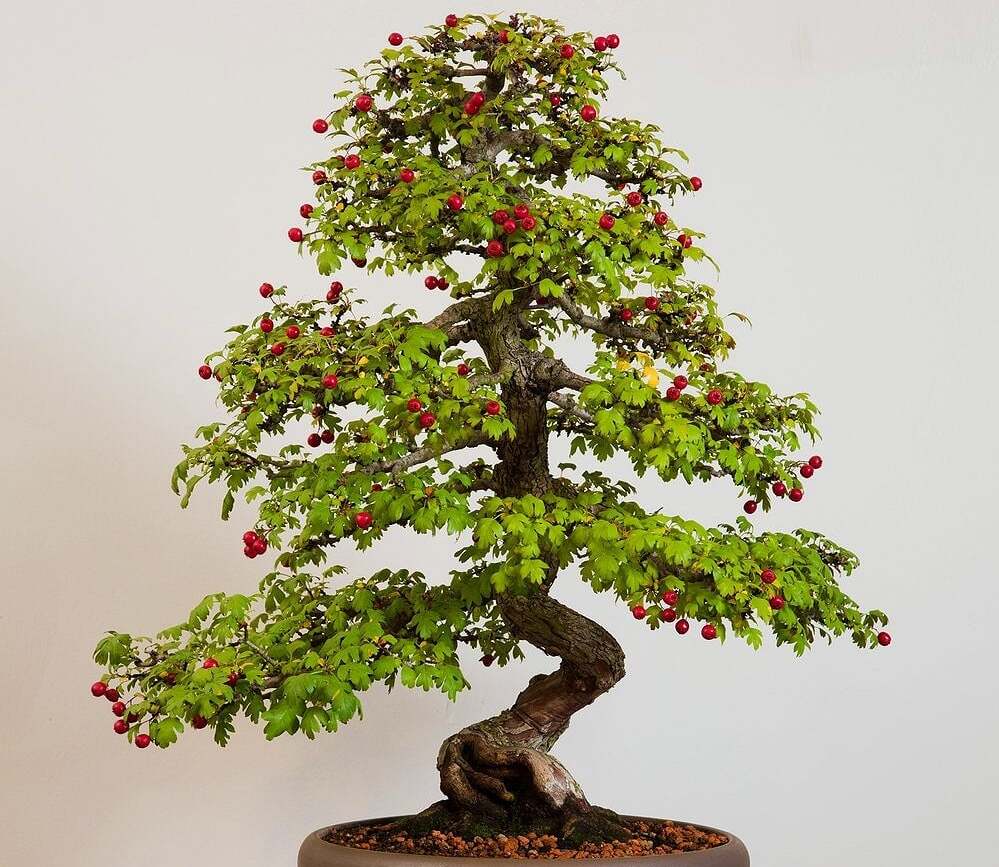
How to Care for and Maintain Hawthorn Bonsai
Caring for and maintaining a hawthorn bonsai is simple, but it demands continuous attention and care. Here are some pointers to maintain your hawthorn bonsai healthy and flourishing:
- Watering: Water your hawthorn bonsai on a regular basis, but don’t overwater it. The soil should be damp but not sopping wet. Allow the soil’s top layer to dry between watering cycles. Watering frequency varies according to temperature, humidity, and season.
- Fertilizing: During the growing season (spring and summer), apply a balanced fertilizer to your hawthorn bonsai every four to six weeks. Use fertilizer with equal parts nitrogen, phosphorus, and potassium. Reduce fertilizing frequency during the dormant season (autumn and winter).
- Pruning: Prune your hawthorn bonsai regularly to maintain its shape and control its growth. Remove any dead, damaged, or overgrown branches. Pinch back new growth to encourage branching and create a denser canopy. Prune in the early spring before new growth appears.
- Wiring: Use bonsai wire to shape and direct the hawthorn bonsai’s branches. Remove the wire after six to eight weeks to prevent it from cutting into the bark. Avoid wiring during the dormant season.
- Sunlight: To grow, hawthorn bonsai require enough of sunshine. Place it in a bright spot where it will receive at least six hours of direct sunshine every day. Artificial grow lights can be used to augment natural sunlight if necessary.
- Temperature: Hawthorn bonsai thrive in cold, temperate climates. Avoid subjecting it to high heat. Keep it somewhere with a temperature range of 60 to 75 degrees Fahrenheit.
- Repotting: Repot your hawthorn bonsai every two to three years. Use a well-draining bonsai soil mix and a pot that is slightly larger than the current one. Repot in the early spring before new growth appears.
By following these care and maintenance tips, you can help your hawthorn bonsai thrive and remain healthy for years to come. Regular attention and care will ensure that your hawthorn bonsai remains a beautiful and cherished addition to your home or garden.
Hawthorn Bonsai Care Sheet
| Aspect | Brief Care Tips |
| Watering | Water regularly, but avoid overwatering |
| Fertilizing | Apply a balanced fertilizer every 4-6 weeks during the growing season |
| Pruning | Prune regularly to maintain shape and control growth |
| Wiring | Use bonsai wire to shape and direct branches, but remove wire after 6-8 weeks |
| Sunlight | Place in a sunny location and supplement natural sunlight with artificial grow lights if necessary |
| Temperature | Keep in a cool, temperate climate |
| Repotting | Repot every 2-3 years using a well-draining bonsai soil mix and a slightly larger pot than the current one |
Conclusion
A charming and satisfying addition to any bonsai collection is hawthorn bonsai. You may develop a unique and gorgeous tree that will provide delight and beauty to your home with the correct growing circumstances, trimming and wiring procedures, and care and upkeep.
FAQ:
Q: Is hawthorn bonsai suitable for beginners?
A: Yes, hawthorn bonsai is suitable for beginners as it is relatively easy to care for and forgiving of mistakes.
Q: What soil mix should I use for hawthorn bonsai?
A: Use a well-draining bonsai soil mix with a pH between 6 and 7. Avoid using regular potting soil, which can retain too much moisture and suffocate the roots.
Q: Can hawthorn bonsai be kept indoors?
A: It is not recommended to keep hawthorn bonsai indoors for extended periods of time as they require plenty of sunlight and fresh air.
Q: How often should I fertilize my hawthorn bonsai?
A: Fertilize your hawthorn bonsai every 4-6 weeks during the growing season (spring and summer) using a balanced fertilizer with equal amounts of nitrogen, phosphorus, and potassium.
Q: Can I wire my hawthorn bonsai during the dormant season?
A: It is not recommended to wire your hawthorn bonsai during the dormant season as the branches may be more brittle and prone to damage.
Q: How often should I prune my hawthorn bonsai?
A: Prune your hawthorn bonsai regularly to maintain its shape and control growth. Prune in early spring before new growth appears, and remove any dead, damaged, or overgrown branches.
Q: How often should I water my hawthorn bonsai?
A: Water your hawthorn bonsai on a regular basis, keeping the soil moist but not wet. Allow the top layer of soil to dry between watering sessions and regulate the frequency of watering according on temperature, humidity, and season.
Q: When should I repot my hawthorn bonsai?
A: Repot your hawthorn bonsai every 2-3 years using a well-draining bonsai soil mix and a slightly larger pot than the current one. Repot in the early spring before new growth appears.
Also Read:


